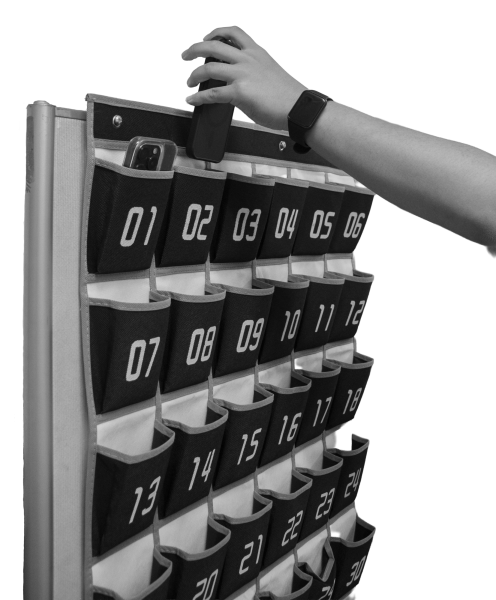
designated cubby as required by new district policy. (Alexander Lawson)
Phones in wooden boxes. Numbered pockets on the wall. Classrooms across California and classrooms at Palo Alto High School are marked with this familiar view.
The Palo Alto Unified School District adopted a policy this year in which phones are put away at the front of the room before class each day.
According to Paly junior Lily Liu, the policy has helped her and other students stay focused during classes.
“Now that we’re forced to put our phones away, we have to pay attention,” Liu said. “So I’ve learned more, which is the good part.”
However, student opinions aren’t all positive. Junior Johnathan Mazor-Hoofien said that the policy is only effective as being a detriment to focused students.
“It only harms students who are being attentive in class by giving them less resources and less accessible ways to access the internet,” Mazor-Hoofien said. “Kids who slack off in class already have multiple other methods, and it’s not at all a challenge for them to keep slacking off. I just feel like it’s very unnecessary, and it’s one of the many policies that Paly has that completely beats around the bush of what it wants to do.”
The district’s decision is following Governor Gavin Newsom’s signing of Assembly Bill 3216, the Phone-Free School Act, to require every school district, charter school, and county office of education to adopt a policy limiting or prohibiting the use of smartphones by July 1, 2026.
The change comes after parent-led movements nationally have pushed for phone ban policies, including groups such as the Distraction Free Schools Policy Project and Smartphone Free Childhood US. Still, the support hasn’t been unanimous, with some parent groups opposing the change due to concerns about accessibility in emergency situations.
Despite some success so far, science teacher Samuel Howles-Banerji said that the policy creates inequity between students with personal Apple computers and students with school-issued chromebooks.
“The piece that we haven’t quite figured out how to deal with is that your computer [Macbook] is essentially a phone as well,” Howles-Banerji said. “My frustration with that is more that it creates inequities, because if you’re using school issued Chromebooks, you can’t do that [phone mirroring], but if you have an iPhone and MacBook, now you can.”
Among mixed feelings, students are still adjusting to the new policy. According to Brendan Lin, he is starting to see the benefits of the policy despite his initial thoughts.
“The phone ban has really improved my productivity during class, because I don’t feel like I ever need to check my phone for notifications,” Lin said. “I wasn’t happy at first, but after a month, I’m kind of getting used to it.
Howles-Banerji said that he hopes that the policy will continue to evolve to support student needs.
“It [phone ban] is not gonna be perfect, but you have got to start somewhere,” Howles-Banerji said.